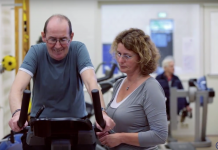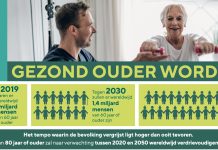Beeldregistratie symposium Cervicale manipulaties
Nieuws over fysiotherapie en de fysiotherapeut › Forums › Casuïstiek › Orthopaedische aandoeningen › Beeldregistratie symposium Cervicale manipulaties
- Dit onderwerp bevat 1 reactie, 2 deelnemers, en is laatst geüpdatet op 12 jaren, 1 maand geleden door
 wimkes.
wimkes.
- AuteurBerichten
- 08/11/2013 om 13:55 #17520
 RobSleutelbeheerder
RobSleutelbeheerderDe beeldregistratie van het symposium Cervicale manipulaties van 2 november 2013 is nu te bekijken op de website van de SOMT.
Gebruik deze links
deel 1 http://fys.io/somt-cwk-mt-1
deel 2 http://fys.io/somt-cwk-mt-2 - 08/11/2013 om 17:28 #17521
 wimkesDeelnemer
wimkesDeelnemerGeachte collegae,
Op 2 november jl. woonde ik het symposium cervicale manipulatie bij. Hoe professioneel en waardevol ik de presentaties van de verschillende deskundigen ook vond, ik kon mij wat minder vinden in de conclusies van Annelies Pool. In haar introductie begon ze te zeggen dat ze geen expertise had met betrekking tot de nek. Tijdens de panaldiscussie deelde zij mede dat de manueeltherapeuten inmiddels een brief op de mat hadden gehad met blijkbaar een ander standpunt dan het eerdere waarbij hoogcervicale manipulaties door haar en het bestuur van de NVMT werden afgeraden. Ik was hier niet van op de hoogte.
Toen er over de incidentie van CAD/CVA’s na cervicale manipulatie werd gesproken refereerde Annelies Pool naar het eerder genoemde werk van Puentedure et al. (JMPT 2012) die over een periode van 60 jaar! (1950-2010) 135 cases onderzochten.
Limitations
1. Puentedura et al zeggen zelf: “There may have been discrepancies between what was reported in the cases and what actually occurred, since physicians dealing with the effects of the AE, rather than the clinician performing the CSM, published many of the cases.” Veel ruimte voor bias dus. Een CVA patient die door een chiropractor of manueel therapeut gezien is, wordt vaak door meerdere neurologen (vanwege wisseldiensten) beoordeeld. Dezelfde patient wordt dan dus vaker gerapporteerd door de verschillende neurologen.Verder zijn er nogal een aantal andere tekortkomingen (‘flaws’) in deze studie op te merken:
2. Van de 134 genoemde casussen waren er 50 met een arteriele dissectie en 18 met een CVA, waarvan niet duidelijk was of die (deels) bij de 50 cassussen van arteriele dissectie hoorden. Immers, een groot deel van arteriële dissecties resulteren in een beroerte. Bovendien is het zo dat in young patients, spontaneous CAD is the cause of up to one-fourth of strokes (Schievink and Roiter, Front Neurol neurosci 2005). Hoe verhoudt dit zich met genoemde casussen?
3. Chiropractors were involved in the majority of injuries following CSM with 69.4% (n = 93) of the cases analyzed. Hierover later meer. Osteopathic physicians were involved in 8.2% (n = 11) of the cases. Physical therapists accounted for 3.7% (n = 5) of the cases; whereas, 11.9% (n = 16) did not report the practitioner performing the CSM. Non-clinicians, including bone setters, barbers, and masseurs accounted for 6.7% (n = 9) of the CSMs.
Van de 134 casussen was er van 25 niet bekend welke professie de behandelaar had of was de behandelaar niet gekwalificeerd. Wanneer je die niet meetelt gaat het over 109 casussen. Om dit alles in perspectief te zien gaat het dus om hoogstens 68 gevallen van CAD/CVA in 60 jaar over de hele wereld. Wanneer we dit relateren aan de honderden miljoenen cervicale manipulaties die hier aan voorafgegaan zijn lijkt een uitleg over de risk/benefit ratio in deze overbodig.
4. Zoals Emiel van Trijffel in zijn presentatie duidelijk illustreerde hebben case reports de laagste graad van wetenschappelijk bewijs. In case studies is het niet mogelijk om causaliteit en risico te bewijzen. Zo ook dus het werk van Puentedura et al.Toen Wendy Scholten dit in de paneldiscussie aanhaalde en neuroloog Jaap Patijn dit bevestigde reageerde Annelies Pool niet.
Een van de collegae gaf commentaar op de presentatie van prof Cagnie dat de meeste adverse events bij chiropractoren zouden voorkomen (Puentedura et al). Ik heb hier twee op/aanmerkingen over:
1. De meest gemelde adverse events komen uit de landen waar chiropractoren de meeste patienten met nek- en hoofdpijnklachten zich bij presenteren. Dit is zeker het geval in de USA. Het is dan logisch dat chiropractoren de meeste situaties van adverse events tegenkomen. Dit is statistisch gezien nogal logisch.
2. Uit onderzoek van Wenban (Chiropr Osteop 2006, JMPT 2005, J Neurol Neurosurg, J Neurol 2005, Psychiatry 2004, Clin Neurol Neurosurg 2008) en Wenban en Bennett (Int J Clin Pract. 2011) bleek dat de titel ‘chiropractor’ en de term ‘chiropractic manipulation’ in relatie tot adverse events na cervicale manipulatie in Europa vaak ten onrechte gebruikt wordt. Ik citeer: ”In each of the six publications the authors suggest the care provider was a chiropractor and that each patient received chiropractic manipulation of the cervical spine prior to developing symptoms suggestive of traumatic injury. In two of the four case reports contact with the principal researcher revealed that the care provider was not a chiropractor, as defined by the World Federation of Chiropractic. The authors of the other two case reports did not respond to my communications. In the case series, which involved twenty relevant cases, the principal researcher conceded that the term chiropractor had been inappropriately used and that his case series did not relate to chiropractors who had undergone appropriate formal training. The author of the secondary report, a British Medical Journal editor, conceded that he had misused the title chiropractor. Letters to editors were accepted and published by all four journals to which they were sent. To date one of the four journals has published a correction.”
CONCLUSION:
“The results of this year-long prospective review suggests that the words ‘chiropractor’ and ‘chiropractic manipulation’ are often used inappropriately by European biomedical researchers when reporting apparent associations between cervical spine manipulation and symptoms suggestive of traumatic injury.”
Ook Terrett (JMPT 2005) concludeerde hetzelfde: ” The words chiropractic and chiropractor have been incorrectly used in numerous publications dealing with SMT injury by medical authors, respected medical journals and medical organizations. In many cases, this is not accidental; the authors had access to original reports that identified the practitioner involved as a nonchiropractor. The true incidence of such reporting cannot be determined. Such reporting adversely affects the reader’s opinion of chiropractic and chiropractors.”
Techniek
Neuroloog Jaap Patijn wees op zijn ervaring m.b.t. cervicale dissecties. De gebruikte techniek zou van belang zijn. Uit onderzoek is echter gebleken dat:
“To date, there has been no reported relationship between the type of manual therapy and risk of stroke, as stroke symptoms have been reported to begin immediately after the first manipulation or several treatments. Some authors have found no relation between the number of chiropractic manipulations and the incidence of cervical artery dissection. In patients with neck manipulation, strokes have been reported to occur after any form of standard cervical manipulation technique including rotation, extension, lateral flexion and non-forced and neutral position manipulations” (Paciaroni M, Bogousslavsky J., J Neurol 2009).
Incidentie
Mbt de incidentie van adverse events wordt ook de survey Margereya et al. (Manual Therapy 2004) met als titel ‘Pre-manipulative testing of the cervical spine review, revision and new clinical guidelines” door Puentedura et al. (JMPT 2012) en door Annelies Pool aangehaald.
Adverse effects (dus geen adverse events) werden geschat als 1:50.000. Er bleken echter geen serieuze complicaties (AE’s) te hebben plaatsgevonden. Ik citeer: ” Specifically, there were no reported major complications in this sample.” En even verder: ” The rate of adverse effects from HVT techniques of the cervical spine (1 per 50,000 manipulations) was very low, with no evidence of catastrophic misadventures. Adverse effects en adverse events zijn hier dus door elkaar gehaald. Er waren in dit onderzoek geen adverse events.
Verder staat er: ” The most common effects related to passive mobilizing techniques (27.5%), examination techniques (20.4%) and HVT techniques (16.1%).” Er kwamen dus meer adverse effects voor bij mobilisatie en examinatie in vergelijking met High Velosity Thrust technieken. Is het door elkaar halen van adverse effects en adverse events een slordigheidje van Puentedura?Zowel Prof Cagnie als Annelies Pool verwijzen in de tweede video (http://www.somt.nl/cervicalemanipulaties/) naar het aantal van 1,3 CVA’s per 100.000 cervicale manipulaties. Ze verwijzen naar het werk van Miley at al. (Neurology 2008) en Wynd at al., (2012,http://www.plosone.org/article/info%3Adoi%2F10.1371%2Fjournal.pone.0059170 ). Annelies Pool geeft een berekening en concludeert dat met 4000 manueel therapeuten in Nederland er 1 a 2 CVA’s per jaar (blijkbaar waren er geen CVA’s na cervicale manipulatie in 2007, 2008, 2009, 2010, 2011 en tot nog toe in 2013) voor komen. Betekent dit dan dat elke manueel therapeut 25 cervicale manipulaties per jaar uitvoert? Verder zegt Annelies Pool dat de IGZ heeft gerapporteerd dat deze 1 a 2 CVA’s een jaarlijks fenomeen zijn. Ik en onze organisatie zijn hier niet mee bekend. Ik hoor dit voor het eerst. En chiropractoren werken al sinds 1965 in Nederland! En waarom zien we niet frequent CAD’s en beroertes na veel krachtiger bewegingen van de nek zoals bij het boksen (kijk maar eens naar een bokswedstrijd; de nekbeweging is vaak een combinatiebeweging van extensie, lateroflexie en rotatie), bij ski ongelukken, rugby en voetbal? Het antwoord is dat het lichaam goed ontworpen (designed) is. De arterieën zijn flexibel, zijn gelocaliseerd in een beschermd gebied en diepte en, zoals Symons et al. hebben aangetoond, “only a modest fraction of external forces are transmitted to them through the various intervening tissues.” Anders dan exceptionele krachten , zijn krachtige bewegingen van het hoofd en de nek geen probleem voor de cervicale arterieën.
According to Miley et al. (neurology 2008) the best available estimate of VAD or occlusion attributable to manipulation is 1,3 per 100.000 manipulations. These are the figures they use in their presentations (in video 2 prof Cagnie addresses this from minuute 18 onwards and Annelies Pool again from minute 1:05). Other experts estimate the association to be 1:400.000 to 1: 5,85 milion (minute 11 from presentation prof Cagnie, Dvorak 1985, Lee 1995, Klougart 1996 and haldeman 2002).
Waarom zou de 1,3:100.000 kloppen en niet de 1: 5,85 miljoen? Deze getallen geven in ieder geval aan dat de incidentie niet bekend is.In summary, the main articles they refer to are form Miley et al, Puentedura et al. and Wynd et al. In minute 14 Prof Cagnie addresses the Cassidy study. She explains that Cassidy concludes that patients with neck and headache may have a CAD allready in progress. However she states that it is not likely that all the patients are in this state when they present to a ‘kraker’ (in this case a chiropractor) and assumes that there may be a causality. I (Wim Kes) think this assumption/conclusion of Prof Cagnie is wrong because the does not explain why the same amount of CAD’s happen when consulting a GP’s.
When a chiropractor exacerbates a CAD/VAD in progress what does a GP do to exacerbate the same problem? When a CAD/VAD occurs after a consultation with a chiropractor the chiropractor is to blame, when the same occurs in a GP visit its coincidence? My conclusion (Wim Kes) would be that a dissection in progress could lead to a CAD no matter who intervenes (GP or chiropractor) and what treatment they receive. This means that the actual manipulation is not the cause.Cassidy et al. geven aan dat “a recent high quality trial found spinal manipulation more effective for acute and subacute neck pain, over both the short and long term” than NSAIDS or paracetamol. De auteurs pleitten echter niet voor het niet meer voorschrijven van deze medicatie, ondanks de goed gedocumenteerde schades die deze medicijnen vaak geven. Waarom moeten patienten voor deze medicatie geen informed consent formulier tekenen?
Cassidy at al. concluderen verder dat “the evidence clearly suggests that manipulation benefits patients with neck pain.”
Another interesting article is that from Murphy (Chiropr osteop 2010, http://www.ncbi.nlm.nih.gov/pmc/articles/PMC2922298/). Prof Cagnie citeert/presenteert dit artikel van chiropractor Murphy bijna letterlijk.Ik denk dat we voorzichtig moeten zijn met al te harde conclusies uit de aangehaalde studie van Wynd et al (2013) te trekken (zie de citaten hier onder).The paper from Wynd et al. (2013) examined the quality of literature describing an association between cSMT and CAD. Case reports represented the majority of this literature. Since these reports may contribute to further understanding CADs as they relate to manual therapy, it is important that they are of the highest quality. This study has demonstrated that the literature infrequently reports useful data toward understanding the association between cSMT, CADs and stroke. As a result, the value of these reports toward informing our understanding of the relation between cSMT and CAD is minimal. De conclusie van het door Pool aangehaalde artikel van Wynd et al. (2013) is duidelijk: de literatuur levert weinig bruikbare data en de waarde van deze reports zijn minimaal. Geen ‘wetenschappelijk’ onderzoek waar dus veel waarde aan gegeven kan worden.
Zie de conclusies door Wynd et al:
This study has demonstrated that the literature infrequently reports useful data toward understanding the association between cSMT, CADs and stroke.
Overall, the quality of case reports examined in this study was low in that they infrequently contained more than 5 of the 11 relevant factors.
In studying the association between cSMT and CAD, it is important to understand the events preceding the application of cSMT and the onset of CAD. Unfortunately, the results from this study demonstrate a general deficiency in reporting events preceding cSMT or CAD other than that the patient presented to the emergency clinic following cSMT. Clearly, case reports discussing the development of a stroke should endevour to include an etiological work-up so that an alternative cause of the patient’s presentation might also be elucidated.
This paper clearly demonstrates that there is a critical need to report all events surrounding CAD, not just the event immediately preceding the injury.
The lack of reporting regarding cSMT-specific factors was similar to the under-reporting of other factors. This is an important omission as there is an inherent variability of cSMT techniques used by manual therapists.
Our study has demonstrated that there are deficiencies in reporting key factors associated with CAD and cSMT.
Currently, there is no standardized reporting tool for examining adverse events associated with cSMT.
The diagnosis of CAD is exceedingly difficult and has to be performed with sufficient quality to ensure that the patient had a CAD rather than some other cause of arterial occlusion, stenosis, or hypoplasia. Failure to diagnosis a CAD accurately places a limitation in the interpretation of the data found in the case report.In Olmsted County, the average annual incidence rate for ICAD was 1.72 per 100,000 population (95% CI, 1.13 to 2.32) and for VAD 0.97 per 100,000 population (95% CI, 0.52 to 1.4). The average annual incidence rate for CAD was 2.6 per 100,000 population (95% CI, 1.86 to 3.33). Good outcome (defined as modified Rankin score of 0 to 2) was seen in 92% of patients. (Lee et al. Neurology 2006)
The etiology of spontaneous cervical artery dissection (CeAD) is poorly understood in most patients. Mild cervical trauma preceding the dissection event is a common finding, but many CeAD occur spontaneously. It is likely that genetic factors may increase the risk for CeAD. However, familial cases are excedingly rare. Familial clustering of CeAD may be accidental or associated with genetic or environmental risk factors shared between affected relatives. In this explorative study, we aim to show that specific risk factors for familial CeAD exist. The mean age of the patients with familial CeAD at their first dissections was 38.4 ± 13.3 years. The high prevalence of multiple dissection events and of long-term (>1 year) recurrent dissections in patients with a familial history of CeAD indicates that a specific predisposition for familial CeAD exists.The incidence of spontaneous CAD is approximately 5 per 100,000 per year and is highest in autumn. The long-term recurrence rate is only approximately 1% per year, but it is higher in patients with familial arterial disease. (Schievink and Roiter, Front Neurol neurosci 2005).
Wanneer ik de rol van Annelies Pool onder de loep neem kom ik tot de gedachte dat zij haar uiterste best doet om aan te tonen dat cervicale manipulatie gevaarlijk is:
1. Zij gebruikt het getal 1:100.000 terwijl de range veel wijder is.
2. rekening houdend met de aanwezigheid van 4000 manueel therapeuten in Nederland geeft zij aan dat er 1 a 2 incidenten per jaar gebeuren en komt niet met de data waar dit uit blijkt. Zij vermeld niet dat er in andere jaren geen incidenten waren.
3. Zij noemt de drie incidenten uit 2012 waarbij de CVA klachten direct op de behandelbank ontstonden. Na een bijwerking vond echter bij een van de patienten drie maanden later een CVA plaats. Dus niet direct op de behandelbank.
4. Toen een collega wees op de onmogelijkheid om de casussen inhoudelijk te beoordelen omdat wij de gegevens niet mogen inzien zweeg Pool. Ook namens mijn vereniging is dit verzoek, helaas tevergeefs, gedaan.
5. Via nieuwsflitsen heeft Pool aangegeven geen discussie in het openbaar te willen voeren. Na deze nieuwsflitsen stopte de discussie op het FysioForum direct.Conclusies
• De effectiviteit van cervicale manipulatie is evident. Onder andere het recente rapport van the Bone and Joint Decade 2000-2010 Task Force on Neck Pain and its Associated disorders, waarbij een multidisciplinair team van deskundigen ruim 30.000 artikelen dsonderzochten, beveelt manipulatie aan “as one of several first line treatments for neck pain, whiplash and related headaches based on a systematic review of RCT’s of interventions and research on adverse events.” Ook Bronfort et al, (Ann Intern Med 2012) geven aan dat manipulatie effectief is, meer effectief dan het gebruik van NSAIDS en paracetamol. Ook oefentherapie was superieur tov NSAIDS. Dit wordt door eerder onderzoek bevestigd, waarbij manipulatie in combinatie met oefentherapie het beste werkt – mechanische behandeling voor een mechanisch probleem.
• Er is geen causaal verband tussen CVA/CAD en cervicale manipulatie.
• Er is ook geen bewijs voor een afwezigheid van een associatie. Het is hoogst onwaarschijnlijk dat dissectie volgt na bewegingen van de nek mits een patient zowel een onderliggende predispositie en een of meer triggers heeft (Rubinstein et al. 2006).
• Er is geen bewijs dat mobilisatie veiliger is dan manipulatie. Uit het onderzoek van Michaeli (J Physiotherapy 1993) bleek het tegenovergestelde. Scott Haldeman: “No manipulative or mobilisation technique can be said to have more risk than any other.”
• There has been no reported relationship between the type of manual therapy and risk of stroke. In patients with neck manipulation, strokes have been reported to occur after any form of standard cervical manipulation technique including rotation, extension, lateral flexion and non-forced and neutral position manipulations (Paciaroni M, Bogousslavsky J. (J Neurol 2009).
• Some authors have found no relation between the number of chiropractic manipulations and the incidence of cervical artery dissection(Paciaroni M, Bogousslavsky J., J Neurol 2009).
• Cervical spinal manipulative therapy as performed by the trained clinicians in this study, did not appear to place undue strain on the Internal Carotid Artery and thus does not seem to be a factor in ICA injuries (Herzog et al., JMPT 2012)
• Cervical SMT performed by trained clinicians does not appear to place undue strain on VA, and thus does not seem to be a factor in vertebro-basilar injuries (Herzog et al., Electromyogr Kinesiol. 2012). Prof Walter Herzog, after hearing the claim that manipulation could cause stress and injury to a vertebral artery, wondered if this was actually possible as a matter of biomechanics given the depth and location of the vertebral arteries. There was not “a shred of scientific evidence” to support the injury hypothesis. If there is a true causative relationship between neck manipulation or mobilisation and vertebral artery injury why is injury so rare? As Herzog has suggested in expert testimony, with a true causative relationship one would expect about 100 cases of VBS a week in Canada alone.
• Cervicale manipulatie had geen invloed op pre-existerende lesies van de arteria vertebralis (Wynd at al., Cerebrovasc Dis 2008). Austin et al. (JMPT 2010) waren niet in staat te bevestigen noch te ontkennen dat bij herhaalde cervicale manipulaties er micro schade aan de arteriële vaten zou ontstaan.
• De incidentie van CVA’s na cervicale manipulatie is onduidelijk en wordt geschat op ergens tussen de 1:100.000 en de 1:5,85 miljoen. VBS na manipulatie of mobilisatie is extreem zeldzaam.
• Het is belangrijk om te kijken naar absolute en contraindicaties en de 5 D’s And A’s. Zie in dit kader ook de eerder vermelde onderzoeken van Schievink and Roiter, Front Neurol neurosci 2005 en Lee et al. Neurology 2006) waar predisposities, erfelijke factoren en zelfs de tijd van het jaar een rol kunnen spelen.
• Goede monitoring en verder onderzoek is gewenst.
• De kans op Adverse Events is zeer klein. Ter overweging geef ik enkele voorbeelden waarvan duidelijk de risico”s aangtoond zijn en waarvoor geen informed consent formulier getekend hoeft te worden. Sterker nog, er hoeft naar mijn weten uberhaupt in Nederland geen informed consent voor medisch handelen of voorschrijven getekend te worden (behalve bij bijv euthanasie en uitzonderlijke gevallen). Als voorbeelden noem ik de bekende risico’s bij het gebruik van NSAID’s, het lopen op een loopband (1:20.000 valt dood neer) en het injecteren van de nek op de pijnpoli.”Spinal injections, whether epidural/translaminar or transforaminal, facet injections, are offered to patients with/without surgical spinal lesions by pain management specialists (radiologists, physiatrists, and anesthesiologists). Although not approved by the Food and Drug Administration (FDA), injections are being performed with an increased frequency (160%), are typically short-acting and ineffective over the longer-term, while exposing patients to major risks/complications” (Epstein, Surg Neurol Int 2013).Ik zou willen eindigen met de wijze woorden van Dr Wim Jorritsma die aangaf dat onderzoeksgeld mogelijk beter voor andere zaken aangewend kan worden.
- AuteurBerichten
- Je moet ingelogd zijn om een antwoord op dit onderwerp te kunnen geven.





